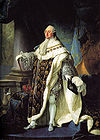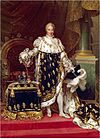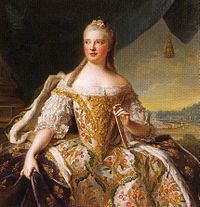- Princess Maria Josepha of Saxony (1731–1767)
-
Marie Josèphe 
Portrait by Jean-Martial Frédou, 1760 Dauphine of France Tenure 9 February 1747 - 20 December 1765 Spouse Louis, Dauphin of France Issue Louis XVI of France
Louis XVIII of France
Charles X of France
Marie Clothilde, Queen of Sardinia
Madame ÉlisabethFull name German: Maria Josepha Carolina Eleonore Franziska Xaveria
French: Marie Josèphe Caroline Eléonore Françoise XavièreHouse House of Bourbon
House of WettinFather Augustus III of Poland Mother Maria Josepha of Austria Born 4 November 1731
Dresden Castle, Dresden, Saxony, modern-day GermanyDied 13 March 1767 (aged 35)
Palace of Versailles, Versailles, FranceReligion Roman Catholicism Maria Josepha of Saxony (Maria Josepha Karolina Eleonore Franziska Xaveria; 4 November 1731 – 13 March 1767) was a Duchess of Saxony and the Dauphine of France. She became Dauphine at the age of fifteen through her marriage to Louis de France, the son and heir of Louis XV. Marie Josèphe was the mother of three kings of France, including the doomed Louis XVI, who died under the guillotine during the French Revolution. Her youngest daughter, Madame Élisabeth, also was beheaded during the Revolution.
Contents
Family
Maria Josepha was born on 4 November 1731 in Dresden Castle to Frederick Augustus II, Prince-Elector of Saxony and King of Poland, and Maria Josepha of Austria, the daughter of Joseph I, Holy Roman Emperor. As a daughter of the Electoral Prince, she was a Duchess in Saxony. Her mother was a first cousin of Maria Theresa of Austria, who in turn was the mother of Marie Antoinette, Maria Josepha's future daughter-in-law.
Maria Josepha was the eighth of fifteen children and the fourth daughter. Her oldest sister Maria Amalia Christina married the future Charles III of Spain in 1738 and had a large family. Her second sister, Maria Margaretha, died in infancy; Maria Anna Sophia became the Electress of Bavaria in 1747. Her eldest surviving brother Frederick Christian became the Elector of Saxony in 1763 and reigned for only 74 days.
Her younger sisters Maria Christina of Saxony and Maria Kunigunde of Saxony were Princess-abbesses of prestigious religious institutions.
Marriage negotiations
As noted, her oldest sister Maria Amalia had married a Spanish prince, Infante Carlos, in 1738. He was a member of the House of Bourbon. The Dauphin of France had been married to the Infanta Maria Teresa Rafaela of Spain since February 1745. The couple had been very happy together and deeply in love. The Infanta, known as Marie-Thérèse-Raphaëlle in France, died on 22 July 1746 after giving birth to a daughter, the couple's only child, Princess Marie-Thérèse of France. Ferdinand VI of Spain, half-brother of the deceased Marie-Thérèse-Raphaëlle, had offered the Dauphin another Bourbon princess, Infanta Maria Antonietta. Instead, Louis XV and his all-powerful mistress Madame de Pompadour wanted to open up diplomatic channels.
The marriage between Maria Josepha and the Dauphin of France had first been suggested by Maria Josepha's uncle Maurice de Saxe, an illegitimate son of Maria Josepha's grandfather Augustus II. Louis XV and his mistress, were convinced that the marriage would be advantageous to French foreign affairs. France and Saxony had been on opposing sides in the recent War of the Austrian Succession and thus the marriage between the Saxon princess and the Dauphin of France would form a new alliance between the two nations.
There was one problem with the suggested bride: Maria Josepha's grandfather Augustus II had dethroned Stanisław Leszczyński (then the Duke of Lorraine). Stanisław was the father of the then Queen of France Maria Leszczyńska. The marriage was said to have humiliated the simple-living Queen, even though the Queen and Dauphine would later get on well.
Other proposals came from Savoy in the form of Princess Eleonora of Savoy or her sister Princess Maria Luisa of Savoy.[1] Both were refused.
Despite the disapproval of the Queen, the two were married on 9 February 1747, Maria Josepha of Saxony married Louis de France, Dauphin of France and Fils de France. Her marriage to a Fils de France ("Son of France") allowed Maria Josepha the style of Royal Highness, the right to travel and lodge wherever the king did, as well as the coveted right of dining with him in an armchair in his presence. However in practice, the Dauphine was addressed as Madame la Dauphine, the more traditional French style prevailing at Versailles till the Revolution.
Marie-Josèphe de Saxe
In France the Saxon princess was known as Marie-Josèphe de Saxe.
Prior to the marriage, tradition demanded that the bride wear a bracelet which had a picture of her father on it; the Queen seeing the Dauphine asked to see the bracelet. The witty Marie-Josèphe then revealing the bracelet to the Queen showed a portrait of the Queen's father. The Dauphine said that the portrait represented the fact that the Duke of Lorraine was Marie-Josèphe's grandfather by marriage. The Queen and the court were strongly impressed by the tact of this girl of 15 years. The Dauphine was also very close to her father-in-law Louis XV.
At the time of the marriage, the Dauphin was still grieving for his Spanish wife. This grief was very public on the part of the Dauphin but Marie-Josèphe was praised greatly for her conquering the heart of the Dauphin "bit by bit". Despite Marie-Josèphe being the patient wife, the Dauphin's grief worsened in April 1748 when his only child with the Infanta died at the age of two.
The Dauphin was deeply affected by the death of Marie-Thérèse, known as Madame Royale, as she was his only link to her deceased mother. Marie-Josèphe, her stepmother, later commissioned a painting (now lost)[2] of the infant to be left over her cradle.
The new Dauphine was very grateful to Madame de Pompadour for helping arrange her marriage, and always maintained a good relationship with the royal mistress. Although it was an arranged marriage, Marie-Josèphe fell in love with the Dauphin.
Like her husband, Marie-Josèphe was very devout. Together with Queen Maria Leszczyńska, she formed a counterbalance to the libertine behaviour of her father-in-law and his court. The couple were not fond of the various entertainments held at Versailles every week, preferring to stay in their apartments which can still be seen on the ground floor of Versailles overlooking the Orangerie.
The couple's first child was a daughter, born in 1750 on the feast day of Saint Zephyrinus and named Marie Zéphyrine. The birth of the Princess, known as Madame Royale, was greeted with much joy by her parents even though Louis XV naturally had been disappointed the child was not a male. This princess died in 1755 without being mourned; in France, a princess had to live at least five years to be formally mourned.[3] Their second child, Louis Joseph Xavier de France, a son born on 15 September 1751, was given the title of duc de Bourgogne, a title traditionally given to the eldest son of the Dauphin of France. Bourgogne was the apple of his parents' eye. His talents appeared early and inspired hope for the future in the hearts of the entire court. He was adored by his older sister Marie Zéphyrine and he adored her too.
Unfortunately, the royal couple concentrated so much time and energy on this eldest son that their other children suffered from neglect. He died on 22 March 1761 at the age of nine at Versailles after having fallen from a toy horse. He started limping and a tumour began to grow on his hip. This was operated on, but he never recovered the use of his legs. He was buried at the Basilica of St Denis.
The couple's second son, Xavier de France, duc d'Aquitaine, born in 1753, died a year later. As a result, their third son, Louis Auguste de France, duc de Berry, born on 23 August 1754, became second in line to the French throne after his father. A strong and healthy boy, although very shy, he excelled in his studies and had a strong taste for Latin, history, geography, and astronomy, and became fluent in Italian and English. Louis Auguste would later become King of France being orphaned at the age of 12.
Thanks to Marie-Josèphe's close relationship with the King and Dauphin, the relationship between father and son soon repaired itself. The Dauphin was at the center of the Dévots, a group of religious-minded men who hoped to gain power when he succeeded to the throne. They were against the way of Louis XV who openly had affairs at court in blatant view of the Queen. Naturally they were not popular with Louis XV.
Her father-in-law named his loving daughter-in-law la triste Pepe; in 1754 Frederick II of Prussia invaded her native Saxony and that started the Seven Years' War in which France later joined. Saxony was pillaged by Frederick. Then in 1757 her mother died aged 58 in Dresden. Her father would die in 1763.
Politically reserved, she exerted herself only once, in 1762, in vain, for the preservation of the Society of Jesus in France. The Society had been dissolved by the King on the initiative of the duc de Choiseul and Madame de Pompadour.
Widowhood
The death of her husband, on 20 December 1765, dealt Marie-Josèphe a devastating blow from which she never recovered, sinking into a deep depression for the rest of her life. Her sisters by marriage, Mesdames Adélaïde, Victoire, and Sophie mourned intensely. The Queen grieved greatly.
To save her the torment of remaining with bittersweet memories of her dead husband, Louis XV allowed her to move at Versailles from the apartments she had shared with her deceased spouse into the apartments of the late Madame de Pompadour, who had died in 1764. There, he visited her more than he had in the past and discussed with her the possible wedding of her son, the new dauphin. Marie-Josèphe was not pleased with the idea of her eldest son marrying Archduchess Maria Antonia of Austria, the future Marie Antoinette. Their mothers were first cousins, and Marie Antoinette's mother had seized the inheritance of the Habsburg Empire from Marie-Josèphe's mother.
Soon, her health declined. She died on 13 March 1767 of tuberculosis, and was buried in the royal crypt in Saint-Denis. The marriage of her son Louis Auguste with Maria Antonia was celebrated three years later.
Issue
Name Portrait Lifespan Notes Marie Zéphyrine de France
Madame Royale
26 August 1750 -
1 September 1755 (aged 5)Born at Versailles, she was known as Madame Royale at court; died at Versailles aged 5 Louis Joseph Xavier de France
Duke of Burgundy
13 September 1751-
22 March 1761 (aged 9)Heir of the Dauphin, he died at Versailles aged 9 much to the distress of his family; Xavier Marie Joseph de France
Duke of Aquitaine
8 September 1753 –
22 February 1754 (aged 0)Born at the Palace of Versailles dying there aged 5 months; Louis Auguste de France
King of France
Duke of Berry
23 August 1754 –
21 January 1793 (aged 38)Born at Versailles, was later husband of Marie Antoinette and King of France; had issue; Louis Stanislas Xavier de France
King of France
Count of Provence
17 November 1755 –
16 September 1824 (aged 68)Born at Versailles, he married Princess Marie Josephine Louise of Savoy and had no issue; later King of France; Charles Philippe de France
King of France
Count of Artois
9 October 1757 –
6 November 1836 (aged 79)Born at Versailles, he married Princess Maria Theresa of Savoy and had issue; was later King of France; Marie Adélaïde Clotilde Xavière de France
Queen of Sardinia
23 September 1759 –
7 March 1802 (aged 42)Born at Versailles, she married the future Charles Emmanuel IV of Sardinia and had no issue; Élisabeth Philippine Marie Hélène de France
Madame Élisabeth
3 May 1764 –
10 May 1794 (aged 30)Born at Versailles, she never married and was executed in the French Revolution aged 30; Maria Josepha also had a stillborn son in 1748 and again in 1749. A stillborn daughter in 1752; Stillborn son in 1756. She also miscarried a son in 1762
Ancestry
See also
Titles, styles, honours and arms
Titles and styles
- 4 November 1731 - September, 1733 Her Highness Duchess Maria Josepha of Saxony
- 9 February 1747 – 20 December 1765 Her Royal Highness the Dauphine of France (Madame la Dauphine [de France])
- 20 December 1765 – 13 March 1767 Her Royal Highness the Dowager Dauphine of France
Maria Josepha's father held the title of king of Poland. However, children of Polish kings were explicitly forbidden the use of the title of prince or princess of Poland.
References
- ^ niece of the Queen of Spain of the same name
- ^ MARIE-THÉRÈSE, FILLE AÎNÉE DU DAUPHIN LOUIS-FERDINAND
- ^ Spawfourth. Tony, Versailles, New York, 2008, p.200-1
Princesses of Saxony, duchesses in Saxony by birth 1st generation Princess Katharina • Anna, Landgravine of Hesse • Katharina, Electress of Brandenburg2nd generation Amalia, Duchess of Bavaria-Landshut • Anna, Electress of Brandenburg • Margarete, Princess-Abbess of Seusslitz • Margaret, Electress of Brandenburg • Margarete, Countess of Glatz • Hedwig, Princess-Abbess of Quedlinburg3rd generation Christina, Queen of the Kalmar Union • Katharina, Archduchess of Further Austria • Margarete, Duchess of Brunswick-Lüneburg • Princess Anna4th generation Princess Anna • Princess Agnes • Christine, Landgravine of Hesse • Magdalena, Electoral Princess of Brandeburg • Princess Margarete • Sibylle, Duchess of Saxe-Lauenburg • Marie, Duchess of Pomerania-Wolgast • Emilie, Margravine of Brandenburg-Ansbach • Sidonie, Duchess of Brunswick-Kalenberg • Princess Margarete5th generation Anna, Princess of Orange • Princess Eleonore • Elisabeth, Countess Palatine Johann Casimir of Simmern • Princess Marie • Dorothea, Duchess of Brunswick-Wolfenbüttel • Princess Amalie • Anna, Duchess of Saxe-Eisenach6th generation Princess Anna Sabine • Sophie, Duchess of Pomerania • Princess Elisabeth • Dorothea, Princess-Abbess of Quedlinburg7th generation 8th generation Princess Sibylle Marie • Erdmuthe Sophie, Margravine of Brandenburg-Bayreuth9th generation none10th generation none11th generation Maria Amalia, Queen of Spain* • Princess Maria Margaretha* • Maria Anna Sophia, Electress of Bavaria* • Maria Josepha, Dauphine of France* • Maria Christina, Abbess of Remiremont* • Princess Maria Elisabeth* • Maria Kunigunde, Abbess of Essen*12th generation Maria Amalia, Duchess of Zweibrücken • Princess Maria Anna • Princess Maria Theresia • Maria Christina, Princess of Carignan13th generation Princess Maria Augusta, "Infanta of Poland" • Princess Amalie • Princess Maria Ludovika • Maria Ferdinanda, Grand Duchess of Tuscany • Princess Maria Johanna • Princess Maria Theresia • Maria Anna, Grand Duchess of Tuscany • Maria Josepha, Queen of Spain14th generation Princess Maria • Elisabeth, Duchess of Genoa • Princess Sidonia • Anna, Hereditary Grand Duchess of Tuscany • Margaretha, Archduchess Charles Louis of Austria • Sophie, Duchess Karl Theodor in Bavaria15th generation Princess Maria • Princess Elisabeth • Princess Mathilde • Maria Josepha, Archduchess Otto Francis of Austria16th generation Princess Maria • Margarete Karola, Princess of Hohenzollern • Maria Alix, Princess of Hohenzollern-Emden • Anna, Archduchess Joseph Francis of Austria17th generation Princess Maria Josepha • Anna de Afif, Princess of Gessaphe • Mathilde, Princess John Henry of Saxe-Coburg and Gotha18th generation Princess Iris,19th generation none20th generation none* princes royal of Poland and LithuaniaPrincesses of France by marriage 1st generation None
2nd generation 3rd generation 4th generation 5th generation 6th generation None7th generation Infanta Maria Teresa Rafaela of Spain · Princess Maria Josepha of Saxony8th generation Archduchess Maria Antonia of Austria · Princess Maria Giuseppina of Savoy · Princess Maria Teresa of Savoy9th generation 10th generation Archduchess Maria Theresa of Austria-Este*also a princess of France in her own rightDauphines of France Jeanne de Bourbon (1350-1364) · Princess Marguerite of Burgundy (1412-1415) · Duchess Jacqueline of Bavaria (1415-1417) · Princess Margaret of Scotland (1436-1445) · Princess Charlotte of Savoy (1451-1461) · Catherine de' Medici (1536-1547) · Mary, Queen of Scots (1558-1559) · Duchess Maria Anna Victoria of Bavaria (1680-1690) · Princess Marie Adélaïde of Savoy (1711-1712) · Infanta Maria Teresa Rafaela of Spain (1745-1746) · Princess Maria Josepha of Saxony (1747-1765) · Archduchess Maria Antonia of Austria (1770-1774) · Princess Marie Thérèse of France (1824-1830)Categories:- House of Wettin
- Burials at the Basilica of St Denis
- House of Bourbon (France)
- Dauphines of Viennois
- Dauphines of France
- Princesses of France (Bourbon)
- People from Dresden
- Polish princesses
- 1731 births
- 1767 deaths
Wikimedia Foundation. 2010.


